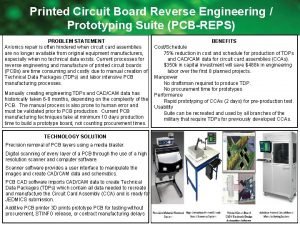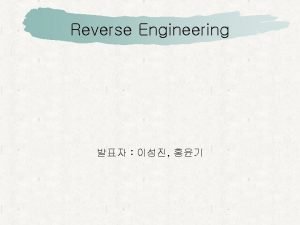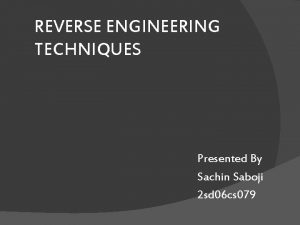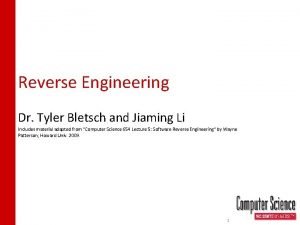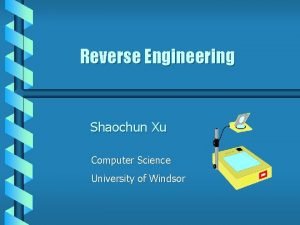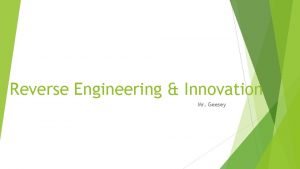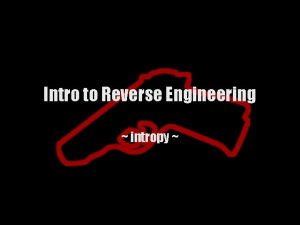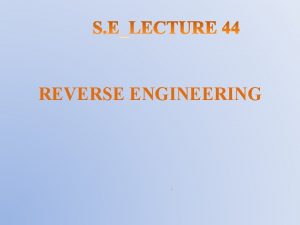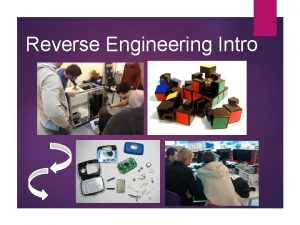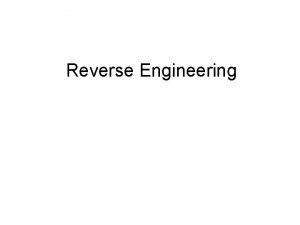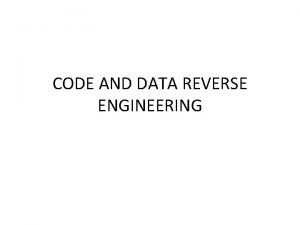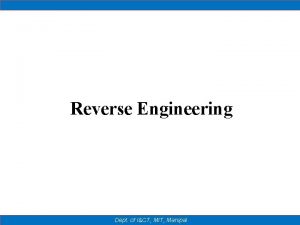Reverse Engineering WHAT is Reverse Engineering Reverse engineering
















- Slides: 16

Reverse Engineering

WHAT is Reverse Engineering? Reverse engineering (RE) is the process of taking something apart and analyzing its workings in detail, usually with the intention of understanding its structure, function, and operation. Microsoft Office clipart

WHY is Reverse Engineering Used? • • Documentation Discovery Investigation Product Improvement ©i. Stockphoto. com

WHY is Reverse Engineering Used? • Documentation – No existing documentation – Interoperability – Maintenance ©i. Stockphoto. com

WHY is Reverse Engineering Used? • Discovery – Academic/research/learning – Curiosity Human Genome Project Reverse-engineer the brain ©i. Stockphoto. com Source: Wikimedia, http: //en. wikipedia. org/wiki/File: Karyotype. png Modified from Human Genomne Project

WHY is Reverse Engineering Used? • Discovery – Academic/research/learning – Curiosity – Military or commercial intelligence B-29 Source: Wikimedia - http: //upload. wikimedia. org/wikipedia/commons/d/d 3/B-29_in_flight. jpg RQ-170 Sourde: Wikimedia, author BBC

WHY is Reverse Engineering Used? • Investigation – Analysis and testing – Document patent infringement – Forensics: Design failure Source: Wikimedia, author: Dr. Lee Lowery Jr. , PE

WHY is Reverse Engineering Used? • Improve or redesign a product – Increase efficiency – Improve reliability – Improve manufacturing techniques – Eliminate failure mode – Reduce cost – Increase-of-use – Reduce negative environmental impacts – Recycle parts – Etc.

Reverse Engineering Tools Micrometers Caliper Source: Wikimedia, author: Christophe Cattelain. Source: Wikimedia, author: Splarka Optical Probe ©i. Stockphoto. com Interactive Visualization Medical Imaging Source: U. S. Air Force photo/Senior Airman Julianne Showalter Insert Picture of 3 D laser scanner or image of scan Source: National Center for Computational Sciences

Stages of Reverse Engineering • Visual Analysis • Functional Analysis • Structural Analysis

Functional Analysis After a product has been selected, a nondestructive functional analysis is performed. • First, the product’s purpose is identified. • Next, observations are made to determine how the product functions. These observations are recorded in detail. • Lastly, the system’s inputs and outputs are listed.

Functional Analysis Example Purpose The purpose of a toothbrush is to clean teeth and gums to prevent tooth and gum decay. Water and a cleansing paste are used in conjunction with the brush.

Functional Analysis Example Function An annotated sketch, with all visible components labeled, is created. A hypothesis is devised to describe (in detail) the sequential operation or function of the device using the sketch as a reference.

Black Box Systems Model A black box systems model is used to identify what goes into and out of the product in order to make it work as a system. Inputs Product Function Output

Black Box Systems Model The “black box” is used to represent the product’s internal components or processes, which are deemed unknown at this point. Inputs Product Function Output

Functional Analysis Example Inputs • • Hand Motion Toothpaste Water Energy Output Product Function • • Sound Heat Waste Clean teeth and gums
 Forward engineering and reverse engineering
Forward engineering and reverse engineering Reverse engineering vs forward engineering
Reverse engineering vs forward engineering Printed circuit borard reverse engineering
Printed circuit borard reverse engineering Non-destructive functional analysis
Non-destructive functional analysis Ollydbg reverse engineering
Ollydbg reverse engineering Reverse engineering team
Reverse engineering team Reverse compilation techniques
Reverse compilation techniques Introduction to reverse engineering
Introduction to reverse engineering Reverse engineering guide
Reverse engineering guide Codebreaker challenge
Codebreaker challenge Reverse engineering computer science
Reverse engineering computer science Reverse engineering
Reverse engineering Intro to reverse engineering
Intro to reverse engineering Malware reverse engineering training
Malware reverse engineering training Functional analysis reverse engineering
Functional analysis reverse engineering Reverse engineering case study
Reverse engineering case study Principles of complex systems for systems engineering
Principles of complex systems for systems engineering


